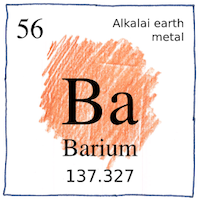Uppsala, London—Carl Wilhelm Scheele,
Humphry Davy
elements

|
Barium
Heating witherite produced baryta, as Lavoisier called it, which is barium hydroxide, also called barote, or baryte, all from the Greek word meaning heavy. Carl Wilhelm Scheele recognized barium was a new heavy “earth” from testing small crystals of barium oxide he found in pyrolusite, a manganese mineral. Scheele wasn’t able to reduce his barium oxide to pure barium. Thirty-four years later, Humphry Davy isolated it using electrolysis and named the new metal barium.
Atomic number 56
Witherite is barium carbonate. Baryte is barium sulfate. Wedgwood’s Jasperware contains barium sulfate. Benitoite (barium titanium silicate) fluoresces blue, the state gem of California. Whereas farmers used witherite as a rat poison, baryte isn’t toxic because it’s insoluble. Barium in a vacuum tube ties up trace gases. Barium sulfate makes a good white pigment for paints. Oil drillers use baryte in their drilling-fluid to help prevent blowouts because it’s insoluable and heavy. Steel, cast iron, alloys with aluminum, zinc, lead, and tin, green fireworks, and high-temperature superconductors contain barium. Minerals frankdicksonite, zhangpeishanite, witherite, alforsite, baryte, radiobarite, barioperovskite, hashemite, muirite, fresnoite, babefphite, nitrobarite, kampfite, sanbornite, norsethite, gamagarite, curetonite, verplanckite, tokyoite, garrelsite-V and -VIII, alsonite, barytocalcide, paralstonite, mackelveyite-(Y) where the Y stands for yttrium, traskite, krasnovite, kuannersuite-(Ce), fencooperite, kukharenkoite-(Ce), zhonghuacerite-(Ce), clinobarylite, barylite, krauskopfite, usovite, and morelandite contain more than forty percent barium. Pure barium doesn’t exist in nature because it readily bonds with nearly everything but unlike nitrogen doesn’t bond with itself.
Stuff that sticks
An electron with a negative charge sticks to its nucleus albeit loosely, according to Coulomb’s law, because the nucleus is postively charged. Given that, I suppose, you might explain why barium, with a valence of positive two, sticks to sulfate, with a valence of negative two. After that, things get a little sticky. Opposites attract but they also clash.



Carl Wilhelm Scheele discovered oxygen three years before Priestly, but Priestley was first to publish. Scheele discovered chlorine but misidentified it. He almost isolated manganese, and almost isolated barium. Acumulated exposure to acids and heavy metals contributed to his death at the age of 43.
See also in The book of science:
Readings in wikipedia:
Other readings: